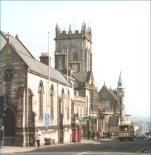Shewy
& Ian's English Life
Ian and Shewy's Comments: No problems at all at Dorchester, passengers loved it.
 Dorchester’s history began over 4,000
years ago at Maiden Castle, about 2 miles south west of the town centre. This
giant hill fort was first occupied in the Stone Age and the people who lived
there enjoyed a comparatively quiet life until it was stormed by the Romans, led
by Vespasian, in 43AD. It was the Romans who founded Dorchester (then called
Durnovaria) in about 70 AD and the Town still bears the marks of their work -
the remains of a Roman town house can be found in Colliton Park, a fragment of
the Roman wall can still be seen near the Top o’ Town roundabout and
Dorchester’s famous tree-lined Walks follow the line of the old Roman artefacts,
including a number of particularly fine mosaics are on display in the Dorset
County Museum.
Dorchester’s history began over 4,000
years ago at Maiden Castle, about 2 miles south west of the town centre. This
giant hill fort was first occupied in the Stone Age and the people who lived
there enjoyed a comparatively quiet life until it was stormed by the Romans, led
by Vespasian, in 43AD. It was the Romans who founded Dorchester (then called
Durnovaria) in about 70 AD and the Town still bears the marks of their work -
the remains of a Roman town house can be found in Colliton Park, a fragment of
the Roman wall can still be seen near the Top o’ Town roundabout and
Dorchester’s famous tree-lined Walks follow the line of the old Roman artefacts,
including a number of particularly fine mosaics are on display in the Dorset
County Museum.
 Dorchester has been the county town
since 1305 and has been instrumental in a number of matter of national, and even
international, significance since. The 17th century was, however, perhaps the
most turbulent in Dorchester’s long history. The town played a prominent part in
the Puritan emigration to America in the 17th century with a local rector, John
White, organising the settlement of New Dorchester in Massachusetts and the
Puritan influence caused the town to be heavily defended against the Royalists
during the Civil War.
Dorchester has been the county town
since 1305 and has been instrumental in a number of matter of national, and even
international, significance since. The 17th century was, however, perhaps the
most turbulent in Dorchester’s long history. The town played a prominent part in
the Puritan emigration to America in the 17th century with a local rector, John
White, organising the settlement of New Dorchester in Massachusetts and the
Puritan influence caused the town to be heavily defended against the Royalists
during the Civil War.
The Town is also renowned as the location of one of Judge Jeffrey’s "Bloody Assizes" which follows the unsuccessful Monmouth rebellion in 1685. Almost 300 men were condemned to death in Dorchester, although many of them subsequently had their sentences reduced to transportation or imprisonment. One of the comparatively few buildings to have survived the series of disastrous fires which ravaged the Town during the 17th and 18th centuries is judge Jeffrey’s Lodgings in High West Street.
Dorchester is well known for its literary associations, perhaps best for Thomas Hardy who both lived and worked here, but there are other, lesser known connections as well. William Barnes, the Dorset dialect poet, had a school here and was Rector of a hamlet just outside the town for many years. Both Hardy and Barnes have statues in the town centre. But Dorchester also has associations with the Powys family, who used to live in High East Street, and with the poet Cecil Day Lewis who, like Hardy, is buried in Stinsford, 1 mile from Dorchester.
There is a memorial by Dame Elizabeth Frink to the Christian martyrs of all persuasions in South Walks and the most recent addition to Dorchester’s enviable collection of public art is a statue of Dorset Shepherd by John Doubleday in Durngate Street.
But Dorchester is a town with a present as well as a past. It is a thriving market town with an attractive pedestrianised town centre and it serves as a focus for the commercial and cultural life of the huge community surrounding the town. The Dorchester festival, which happens at the beginning of may every other year, attracts large audiences from far afield for high quality, varied programmes of entertainment’s and exhibitions.
Shewy&Ian's Comments: No problems here, everything clean and tidy, toilet facilities were adequate and clean
Passengers Comments: Good Day out, no problems with traffic in town, they liked the pedestrianised area, will come again.